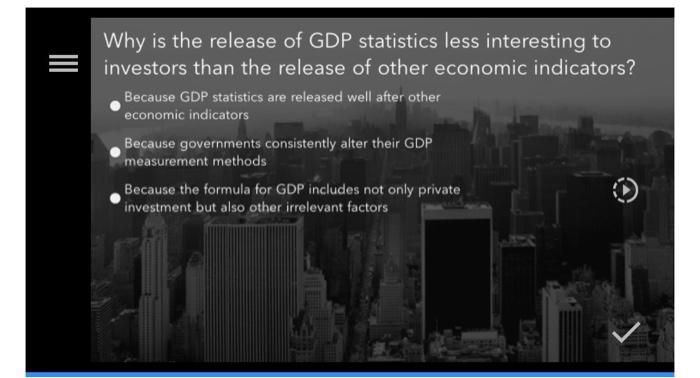Business Inventories and GDP
A change in business inventories is counted in gdp – Changes in business inventories significantly influence the calculation of Gross Domestic Product (GDP), a key indicator of a nation’s economic health. Understanding this relationship is crucial for interpreting economic trends and formulating effective economic policies. This article delves into the intricacies of how inventory adjustments impact GDP, exploring various aspects from calculation mechanics to the influence of external factors.
The Role of Business Inventories in GDP Calculation
Business inventories represent the stock of goods held by firms for sale or use in production. These inventories are considered a form of investment because they represent resources committed to future production and sales. The change in inventory levels – the difference between the value of inventories at the end of a period and the value at the beginning – is included as a component of investment spending in the GDP calculation.
A positive change (inventory buildup) adds to GDP, while a negative change (inventory drawdown) subtracts from GDP.
Types of Inventories Included in GDP Calculations

Source: cheggcdn.com
GDP calculations encompass various types of inventories, including raw materials, work-in-progress, and finished goods. Raw materials are the basic inputs used in production. Work-in-progress represents goods that are partially completed but not yet ready for sale. Finished goods are completed products ready for sale to consumers or other businesses.
Impact of Inventory Changes on GDP Growth
Changes in inventory levels can significantly impact GDP growth or contraction. For example, a sudden increase in consumer demand might lead to a depletion of inventories, resulting in a negative contribution to GDP in the short term. Conversely, an unexpected slowdown in demand might lead to an accumulation of unsold goods, adding positively to GDP, even though this might signal weakening economic conditions.
| Inventory Change | GDP Impact | Example Industry | Economic Effect |
|---|---|---|---|
| Increase | Positive | Automotive (increased production anticipating higher demand) | Appears as economic growth, but might mask weakening future demand |
| Decrease | Negative | Retail (unforeseen surge in holiday shopping depletes stock) | Reflects strong consumer spending, but potentially unsustainable |
| No Change | Neutral | Manufacturing (stable production matching consistent demand) | Indicates balanced economic activity |
| Significant Decrease | Negative | Electronics (supply chain disruption leads to stock shortage) | Signals potential production bottlenecks and economic slowdown |
Inventory Investment in GDP Calculation
Understanding how inventory investment is incorporated into GDP calculations is crucial for accurate economic analysis. This section details the mechanics of this process and compares it to other GDP components.
Increases and Decreases in Inventories and GDP
Increases in inventories contribute positively to investment spending and therefore increase GDP. This is because firms are adding to their stock of goods, representing an investment in future production. Conversely, decreases in inventories reduce investment spending and decrease GDP, indicating that firms are selling more than they are producing.
Inventory Investment vs. Other GDP Components

Source: cheggcdn.com
Unlike consumption, government spending, and net exports, which reflect actual final demand, inventory investment represents a change in the stock of goods. It’s a volatile component of GDP, often reflecting short-term fluctuations in demand rather than long-term economic trends. While consumption reflects current purchases, inventory investment reflects the difference between production and sales.
Hypothetical Scenario: Inventory Buildup, A change in business inventories is counted in gdp
Imagine a major electronics manufacturer anticipating a surge in demand for a new product. They significantly increase production, leading to a substantial inventory buildup. This buildup contributes positively to GDP in the current period, even though the goods haven’t been sold yet. However, if the anticipated demand doesn’t materialize, the manufacturer might face unsold inventory, leading to a negative contribution to GDP in subsequent periods.
- Calculate the value of inventories at the beginning of the period.
- Calculate the value of inventories at the end of the period.
- Determine the change in inventory levels (end-of-period value minus beginning-of-period value).
- Add the change in inventory levels to the other components of investment spending in the GDP calculation.
Interpreting Inventory Changes in GDP Data
While changes in inventories provide valuable insights into economic activity, it’s crucial to interpret them cautiously, acknowledging their limitations and potential biases.
Limitations of Using Inventory Changes as an Economic Indicator
Inventory changes are a volatile component of GDP and can be influenced by factors unrelated to underlying economic strength. For instance, a temporary supply chain disruption might lead to an unplanned inventory drawdown, creating a misleadingly negative impact on GDP figures. Furthermore, inventory data can be subject to revisions and lags, affecting the accuracy of real-time economic assessments.
Potential Biases in Inventory Data Reporting
Inaccuracies in inventory data reporting can arise from various sources, including data collection challenges, reporting lags, and intentional misreporting by businesses. These inaccuracies can lead to misinterpretations of economic trends and potentially influence policy decisions.
Distinguishing Between Planned and Unplanned Inventory Changes
It is crucial to differentiate between planned and unplanned inventory changes. Planned changes reflect anticipated shifts in demand, while unplanned changes are often a response to unforeseen circumstances. Unplanned inventory drawdowns often indicate unexpectedly strong demand, whereas unplanned buildups signal weak demand.
| Period | GDP Growth (Including Inventory Change) | GDP Growth (Excluding Inventory Change) |
|---|---|---|
| Q1 2023 | 2.5% | 2.0% |
| Q2 2023 | 1.8% | 2.2% |
| Q3 2023 | 3.1% | 2.8% |
Inventory Changes and Business Cycles: A Change In Business Inventories Is Counted In Gdp
Inventory fluctuations are intrinsically linked to the business cycle. Understanding this relationship helps in predicting economic trends and mitigating potential risks.
Changes in business inventories are a key component of GDP calculations because they reflect production not yet sold. Understanding how these inventory fluctuations impact the overall economy requires examining the specifics of a businesses change in inventories, which you can learn more about by reviewing this helpful resource: a businesses change in inventories. Therefore, accurately accounting for these changes is crucial for obtaining a precise measure of a nation’s economic output.
Inventory Fluctuations and the Business Cycle
During economic expansions, businesses often build up inventories in anticipation of increased demand. Conversely, during contractions or recessions, businesses may reduce inventories to cut costs and adjust to lower demand. These inventory adjustments can either amplify or dampen business cycle fluctuations.
Inventory Investment as a Leading or Lagging Indicator
Inventory investment can serve as both a leading and a lagging indicator of economic activity. A buildup of inventories can precede a slowdown in economic growth, acting as a leading indicator. Conversely, a decline in inventories can lag behind an economic recovery.
Inventory Changes Amplifying or Dampening Business Cycles
Unexpected changes in inventories can amplify business cycle fluctuations. For example, an unplanned inventory drawdown during a period of strong demand might initially boost GDP but could lead to shortages and price increases later, potentially exacerbating the economic boom. Conversely, an unexpected inventory buildup could worsen a recession by further depressing investment.
Illustration of Inventory Levels and the Business Cycle
Imagine a graph with time on the x-axis and inventory levels on the y-axis. During an economic expansion, the line would show a gradual upward trend, reflecting increasing inventory levels as businesses anticipate growing demand. As the economy approaches a peak, the rate of inventory accumulation might slow down or even reverse, indicating a potential slowdown in demand.
During a recession, the line would show a downward trend, representing inventory drawdowns as businesses adjust to falling demand. The nadir of the line would correspond to the trough of the recession, after which inventory levels would gradually begin to increase again as the economy recovers.
Impact of External Factors on Inventory Levels and GDP
External shocks and policy changes can significantly influence inventory levels and their subsequent impact on GDP. This section explores these influences.
Influence of External Shocks on Inventory Levels
External shocks, such as natural disasters, global pandemics, and trade wars, can disrupt supply chains, leading to unexpected inventory adjustments. For example, a pandemic might lead to both a decrease in production and a surge in demand for certain goods, creating shortages and negatively impacting GDP. A trade war might disrupt imports, leading to inventory shortages and higher prices.
Changes in Consumer Demand and Inventory Adjustments
Changes in consumer demand are a primary driver of inventory adjustments. A sudden increase in demand can lead to unplanned inventory drawdowns, while a sudden decrease in demand can result in unplanned inventory buildups. These adjustments significantly influence the GDP calculation.
Role of Government Policies in Influencing Inventory Levels
Government policies, such as tax incentives for investment or subsidies for specific industries, can influence business decisions regarding inventory management. For example, tax breaks for investment might encourage businesses to build up inventories, positively impacting GDP in the short term. Conversely, policies aimed at reducing consumption might lead to inventory buildups, potentially masking underlying economic weakness.
- Natural Disasters: Can cause supply chain disruptions, leading to inventory shortages and a negative impact on GDP.
- Global Pandemics: Can lead to both supply chain disruptions and shifts in consumer demand, resulting in complex and unpredictable inventory changes and their impact on GDP.
- Trade Wars: Can disrupt imports, leading to inventory shortages and potentially higher prices, negatively affecting GDP.
- Changes in Consumer Confidence: A decline in consumer confidence can lead to lower demand and inventory buildup, potentially masking an economic slowdown.
- Government Stimulus Packages: Can boost demand and lead to inventory drawdowns, positively impacting GDP.
Essential FAQs
What are some examples of unplanned inventory changes?
Unplanned inventory changes often result from unexpected shifts in consumer demand. For instance, a sudden drop in demand might leave businesses with unsold goods, leading to an unplanned inventory increase. Conversely, unexpectedly high demand can result in an unplanned decrease as businesses struggle to keep up.
How does seasonality affect inventory changes in GDP data?
Seasonal fluctuations in demand can lead to predictable inventory changes. For example, retailers often build up inventories before major holidays, leading to a temporary increase. Economists often adjust GDP data to account for these seasonal variations to get a clearer picture of underlying economic trends.
Can inventory changes predict future economic activity?
Inventory changes can sometimes serve as leading indicators of economic activity. A significant build-up of inventories might suggest weakening future demand, while a sharp decline might indicate increasing demand. However, it’s crucial to remember that inventory data is just one piece of the puzzle and should be considered alongside other economic indicators.